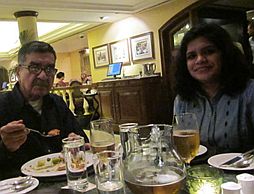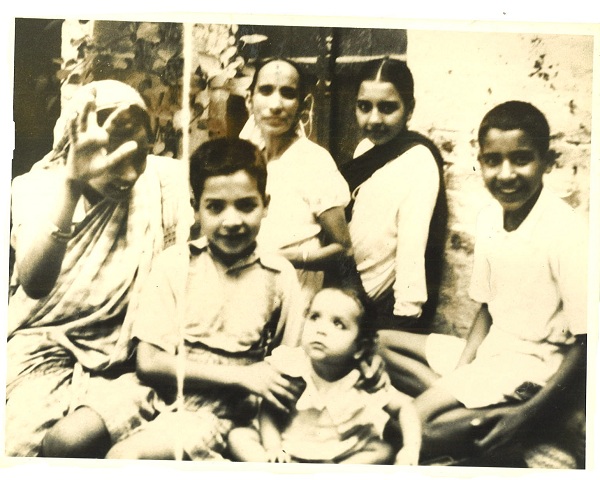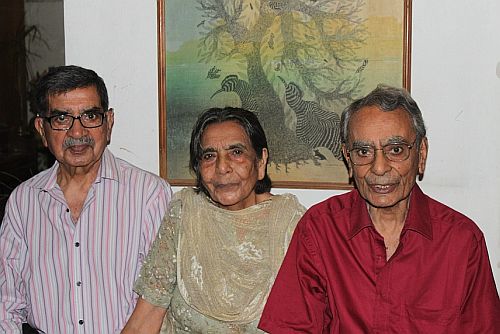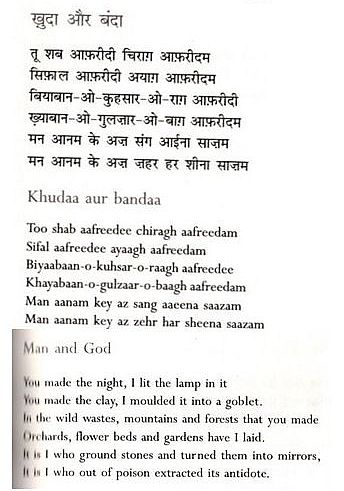My memories of seasons and the foods we ate
Category:
Tags:

Jatinder Sethi, shown with his granddaughter Abha, was born in Lyallpur, now Faislabad, in pre-Independence India. He finished his M.A. (English) from Delhi University in 1956, and went off to London to study Advertising in 1958. He passed his Membership Exam of The Institute of Practitioners in Advertising (M.I.P.A) in1965, and joined Rallis India in Bombay. Later, for over 20 years, he worked for the advertising agency Ogilvy &\; Mather. Now retired, he helps his son in his ad agency in Delhi.
Author's note: On November 8, 2015, with the grace of God, I celebrated my 85th birthday with my immediate family, at our favourite restaurant -"Delhi O Delhi" at the India Habitat Centre, Lodhi Road, Delhi. Abha, my granddaughter, now 23, joined the family celebration. She takes a very keen interest in her grandparents. She had read, and commented on all my earlier stories about my personal and professional life. Since I had not written anything new for quite some time, she asked me why. My answer was that I had no more memories left to tell her. "Dadda, think, there must be some other childhood memories that you could tell us. Please, take your time, think, and write, no matter how short, long or uninteresting, I want to know about it. PLEASE!"That's what motivated me to write this story.
November 8 1930! "Kaka Is Born".
That's what's written in a very old notebook that my father, Pitaji, kept as record. I am the last child - after five brothers and two sisters. Every one's birth was recorded with a holder, relief nib and blue ink. This notebook, with pages becoming yellow, is with Ved, the eldest of my three surviving brothers, who is now 93 (God bless him)

Left to right: Front row: Pritam (elder sister, deceased), with her first child, Shashi (now 74 years), Jatinder (6years)
Back row: Beeji (mother), Santosh(sister, now 90, in Singapore), Satinder (brother, now 88).

Left to right: Ved (called Vedi), Satinder, Jatinder,
Front: Nirmal Bhabi, Ved's wife\; back: Tutu (daughter of Ved and Nirmal)
I believe that my mother was expected to give birth on November 6, but it got delayed by two days. So, it is written that I was born on the 8th day, and missed the 461st birthday of Guru Nanak by two days.
My mother - we all called her Beeji - had told me that 8th November 1930 was part of a very severe winter and freezing cold weather in Punjab. She was feeling very sad on that day for two reasons. One, that she had failed to deliver me, as expected, on Guru Nanakji's birthday. Second, it was the first Guru Nanak birthday that she had to miss going to Guru's Langaar at the Gurdwara. Every year she, along with her friends, used to help make Tandoori rotis and Maan-Choleyan Di Dal for serving in the Langaar. I believe all our family members, except Pitaji, used to go and have food at the Langaar that day. I remember very clearly when I started going there. I was then 6 years old.
Our Time-Tested Seasons
All our seasons are associated and marked with festivals and festivities. Something's having not changed.
Winter is heralded by Diwali festival\; the beginning of Indian Business New Year. Lighting of Diyas, Laxmi Puja and Patakhas (fireworks). I have no actual childhood memories of Diwali in Lyallpur, but I remember clearly going to see Ram Lila every day, and never missing Dussera and burning of Ravana and others at the Dussera Grounds. Pitaji used to take us there. Afterwards, the crowd used to pick up small, burnt bones (wood pieces) as mementos of Ravana. It was believed that if you keep this burnt piece under the pillow of a married woman, she will soon become pregnant. I don't know how far it was true.
If I am not mistaken, Kissan Mandi of farmers used to take place at the same grounds, sometime around the same time. Farmers, zamindars and others used to bring their animals - cows, bulls, buffaloes, goats, horses, camels, etc. - for sale to intended buyers. It used to be a big annual mela. We always used to go there with Pitaji. I believe such melas still take place in smaller towns.
Lohri
Lohri signifies, perhaps, the end of the winter\; or is it the middle of winter season? As kids, we used to wear big decorated Mukats-Chhajjas on our head, and go around collecting money for Lohri. The money was used to buy moongphallis, rewari, gajak, Makki, neozazas - all winter khajas - for burning them in the big wood bon-fire lit in the Mohallas.
And, of course, we also used to sing the Lori song Dulla Bhatti Walla, Sunder Mundriye. Ho, tera kaun vachhara, Ho. Today, as the Seasons are becoming unseasonal, overlapping each other, and even if there is no real winter, we still light the wood fire (in miniature form) and celebrate Lohri by throwing popcorn, rewari and peanuts to keep the ritual alive. Now we play the same song on our smart phones.
Basant
It used to be a big festival when we were in school, ages back. It was the start of Spring. All the kids in the Arya School, Lyallpur, used to wear bright yellow dress with yellow Pagari, and fly kites. I remember that in those days I was learning to play Jaltarang in the school. Every child in Arya School had to choose one musical instrument to learn to play. The music lessons used to start immediately after the Morning Prayer and Hawan. We were supposed to play these instruments in the Basant Mela. Gave it up, like many other ventures, without really learning it.
I also now remember that a Bhai from the gurudwara used to come to our house to teach harmonium to my sister, Santosh, lovingly called Toshi (like I was called Kaku, which is used even now). I suppose it added to her qualifications for finding a good groom. (Never imagined that years later we all will have ‘love' marriages\; successful and eternal.)

Left to Right: Jatinder (85 years), Santosh (90), Ved (93). 2015.
Basant is still celebrated - even in Pakistan. And there is a beautiful song Lo Phir Basant Aaee by Pakistani singer Tahira Syed, daughter of Mallika Pukhraj. Of course, now-a-days, all these festivals are more of a Bhangra dance tamashas in India.
Holi
Or is it the Holi that signifies the end of winter? I am little rusty on my knowledge of "official seasons." Holi was really played as it was done in olden times in Gokul and Mathura\; but now the Indian films have made it into a Bhang and Thandhaee festival. I do not recall, at all, anything about this festival also in my childhood. I wonder if someone else can jog my memory. Now, in India, Holi is associated with the song sung by the Indian film actor Amitabh Bacchan: Holi Hai! I do play Holi along with our local community every year\; but some people have now started avoiding it. We, to avoid people coming and drenching you in Chinese colours, lock our front gate till the afternoon. Shame, isn't it? This is supposed to be the festival when all old rivalries can be washed away and friendship (Bhai-chara) can be renewed. Never seen it happening! Has anyone?
Baisakhi
It is rather surprising that I started the journey back in time at the insistence of my granddaughter, and almost became a child of nine/ten years old\; she was right - I could relive those old memories. Baisakhi was the beginning of Harvest Season in Punjab. We used to get load of wheat (Kank) and hay (Toordi) for our cows &\; buffaloes from our agriculture land in Jhang. (As compensation, after Partition, we got agriculture land near Sonepat, Haryana.)
As a spoiled child, I used to sneak into cinema halls to see "film". And I remember now clearly the film I saw - must be around 1942/43 - the most popular film of that time: Yamla Jat. Pran (the great Indian actor) was the Hero. [Incidentally, Pran, whose full name was Pran Sikand, was at my wedding in Delhi in February 1958 from my wife's side (Sikand family). (I have lost that photo, pity).]
And Noor Jehan was the female lead. The scene, if my memory serves me right, was in the field (khet) where wheat is growing - almost ready to be harvested. The film was timed for release near Baisakhi festival. And the song was Kankan Diyan phaslan Pakian ne-aha ji aha waha Daata (thanking God for good crop). According to Google, the music was by Master Ghulam Haider. And song was sung by Shamshad Begum.
I also remember that when Pitaji came to know that I had gone to the cinema hall, I got a good verbal thrashing, with Beeji trying to protect me. Pitaji, though, never beat any child, ever. He was the noblest of person.
Garmi Ka Mausam Aur Monsoon (Hot days and monsoon).
Those days, I remember, during the Summer season, it was not only really hot-hot, but also we used to get what was called Khooni Aandhi (dust storm) and loo (hot wind). Khas-Khas tattis and hand pankhas (fans) were the solution to protect from zaberdest (strong) garmi (heat) - but only partly. Pit (prickly heat) was common those days, and the best treatment for was to stand naked in the first rains of the Monsoon. It, however, all became bearable with the onslaught of monsoon and mangoes, and the expectation of winter coming.
But work never stopped. You just were not allowed to miss school, on any excuse. Still, we used to get Chutti (day off) if and when the day turned out to be cloudy and pleasant. We students, used to shout "Fine Day, Fine Day", and the Headmaster would declare Chutti. We used to pick up our bags and Takhtis, and run home, without understanding what "Fine day" meant.
I have, frankly, not weathered that kind of severe freezing winter or the karakey ki garmi (extreme heat) since then at the places I have lived after the partition of India: Delhi 1947-1958, London 1958-1964, Bombay 1965-1999, and Gurgaon after that.
In short, seasons in the pre-Partition times, followed much defined periods that made life predictable and you knew what to hope for next, and be prepared. Not anymore.
Various memories and thoughts
One of the few things which are still in vogue and in use during the winter season even today, after 80 years, is the Monkey Cap. You can see children, and young boys, girls, and of course older people like me still using colourful Monkey caps to protect from cold and wind. Now-a-days, you get all this stuff from super market and on the net, ready-made.
In the days I am talking about, everything had to be made at home. My mother used to knit sweaters, scarfs and monkey caps for the family, besides doing all the other work like cooking, sewing.
An interesting point I remember is that while we were six brothers and two sisters, my mother's family was four sisters and two brothers. Guess what? My mother, like me, was the youngest child of her family, and was loved by all her sisters, who were married to Zamindars. It was our Massis (mother's sisters) who used to send gifts like hand-knitted woollens for her children. I can recall now, that one of our Massi from Khushab/Sargodha gave me a Chinese silk shirt with double cuffs and gold cuff-links when I visited her at the age of 10 with my mother. And would you believe if I told you that one of our Massis used to drink hot tea with a lot of butter in it! I swear it's true. (Her brother, Mr. M R Ahuja, (a Diplomat) and her children who were settled in Canada were spellbound when they heard this.) After Partition, this Massis's family got huge agriculture land in Ambala as compensation for the land they lost in Pakistan.
Talking of my mother, I recall, when I was a small child, I used to snuggle in her bed, under the Razai (blanket), while she would be reading her Gutka before going to bed. We all used to have our own Kangrdis, which with burning coal\; we used to hold them under our blankets to keep warm. I wonder if people outside Kashmir still use it, with the availability of hundreds of types of electric heaters. Anyway, winter now is no longer the winter of the 1930s and 1940s of our childhood. When you could really wish and say "if winter comes can spring be far behind".
I remember a lady we all used to call Bhuaji (father's sister), even though my father had no sisters. We had close links with her family. Bhuaji was the lady who had helped my mother in the delivery of her all eight children! My mother's children were born at home, and surprisingly around the winter season. Bhuaji was not a professional mid-wife\; she was the wife of one of Pitaji's friends. She was always available for any help in the house, whenever required in an emergency. They used to live on Chaniot Bazaar, quite close to our home at the Gole Bazaar.
I cannot recall a single day, during all the years of my childhood in Lyallpur, when we ate cold rotis or chapattis. My mother would get everyone to sit around her in the big rasoi (kitchen) while she cooked chapattis, and served us all. There was no gas or cooking stoves. It was the Chullas, three of them together in a row, and anghithi (wood/gobar fire) and Tawa. And in winter, it was very welcome to sit near the fire on the wooden chokis, and enjoy your mother's love. Children enjoying her food were the greatest joy to her. At lunch time, in winter, it was always Tandoor and garma-garm (hot) rotis with lot of butter, churned out in the morning, sitting on manjis (cots, charpais, used in villages for all purposes: sleeping, hooka smoking, eating food) in the back yard under the Sun. My elder sister would help taking out rotis from the tandoor.
Although we had no knowledge of soups, Beeji, while making Kala Channa, would use a lot of water to prepare good amount of curry (Shorba) which was then served as soup in winter. And when one fell sick.
Another speciality of our mother was to make Kali Dal (Maan-di-Dal) in earthenware in the slow Tandoor fire, overnight, to be served a day later. Kali Dal was always served one day after it was cooked. It was supposed to become really tasty. My wife, Uma, is also a very good cook as my mother - but with the help of all the modern equipment. Also served with love, but without the home-made or the white butter, which is a must for Sarson Ka Saag.
Churi (or Choori.) I don't know how many of people today can recall what Churi is. When I was a little child, Beeji used to make Churi for me. She would make a hot Phulka, put lot of ghee, crush it with her fingers, add sugar, and serve with her own hand in to my mouth. She served Churi to all her grandchildren when they were toothless babies. And she used to sing something like "Tanu ghee the churi." I can't recall the words now\; but have a vague idea that sometime the song was addressed to the cawing crow, on the terrace that I will give you Ghee-di-churi if you bring some good news. I wonder if someone recalls this.
My memories, what I can recall of those days, right up to the 1947, and the Partition of the country when I was in the 9th class, also relate to cold weather, Tandoori Rotis, Sarson Ka Saag, home-made white butter, and lot of fresh seasonal vegetables like Phool Gobi, Shulgum, Gajar, Mutter, Moolis. And lot of Meetha achaar (Gobi, Shulgum, Gajar pickle).
Winter was also the time when my mother would make Martbans (big storage containers of Alibaba type) full of Meetha Achaar. And Murabas (preserves) of Gajar. And big earthen pot (Ghara) full of Kanji with lot of black gajars. All this stuff used to get over by the next winter came.
Now-a-days Meetha Achaar is available only in few shops in Delhi. And, that too, only in winter and only in small jars.
Winter was also the time for fresh, inviting to be eaten raw, seasonal vegetables, and in abundance. My love for visiting local subzi-mandis, or weekly bazaar to buy vegetables started in childhood. I have the habit of picking up gajars, moolis, peas, etc., while shopping, and munching them without washing. While in London, from 1958 to 1964, I never missed any week-end going to the market at Camden Town. We used to live in Hampstead then.
The times are a changing, and it's the world of young geeks\; high on technology and low on time. Everything, however, is not lost yet. We still have cycle cartwallas, loaded with all kinds of fresh vegetables fruits, hari-mirch and dhania (two of the most expensive items, now) roaming the streets, and selling door to door to housewives. Advantages? Buy fresh every day for day's requirement instead of stocking for weeks in a fridge. Also have fun of bargaining for rates. And find out what your neighbour is buying, and listens to all the street gossip. And if you have no money handy, you can pay the next day. On Credit! No problem.
Eat only seasonal foods of the Season.
"Eat only seasonal food in the season" was the advice Pitaji used to give and follow in the house. For instance, in winter eat whatever is grown in that season: gobi, shulgum, gajar, matter, moolis, sarson, etc. And in summer eat whatever is the seasonal food. In fact, in my childhood, seasonal foods, say in winter, were available only in winter and not in any other season. That's the reason, women, like my mother, in those days, used to dry these seasonal vegetables so that they could use them in summer. Beeji used to cut large amount of gobi, gajar, shulgum and keep them on the terrace under the sun for drying. And use them in summer, because these were never available in summer season.
But this no longer holds true, you get all these vegetables all through the year, all the 365 days! Season is no season! Since, our climate change is making all seasons Unseasonal, Food habits have also changed. All kind f foods are available round the year.
Now-a-days, we have captured the Nature, Seasons and Seasonal foods, for use any time of the year in our fridges and freezers in our little kitchenettes. Who cares for the Nature any more? Man is progressing, outsmarting and short-circuiting Nature.
A final thought
There was a time when Man, with his ingenuity moulded the creation of God for the good of mankind. I am reminded of a Persian couplet of the great Urdu poet, llama Iqbal entitled Khudaa aur banda (Translation by Late Khushwant Singh)

_______________________________________
© Jatinder Sethi 2016
Editor's note: I approve all comments written by people, provided the comments are related to the story. The purpose of approval is to prevent unwanted commetns, inserted by bots, which are really adverstiments for their products.
Comments
Add new comment